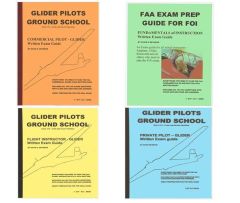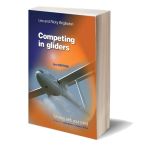Dancing with the Wind
by: Jean-Marie Clement
Dancing With the Wind
by: Jean-Marie Clement


General Description
Dancing With the Wind - The first book dedicated exclusively and exhaustively to slope and wave flying, with the very first aviation details of Hydraulic Jumps, how to identify and use them. New information on the intelligent use of Oxygen.
Published both in English and French, this is the first Manual of Sailplane Slope and Wave soaring techniques. Everything you need to know to fly using the wind, happily and safely.
All about the wind, why, where and how, local breezes, convergences etc.
Explaining tricks and tips of slope soaring and real dangers, from the first slope flying records by Karl Striedieck in the USA until today.
All about the theories of the formation of waves, from Queney to Scorer and Wurtele, including atypical waves and Hydraulic Jumps (Bidone's jump). Specific techniques to use lee waves, especially non-conventional ones, including wake waves. Narratives from pilots having survived a potentially fatal accident.
Theory and application of the “Speed–To–Fly” concept in strong winds. Review of structural limitations and narratives of pilots having exceeded these limitations (after having bailed out).
Review of all health issues linked to mountain and high-altitude flying.
Intelligent use of Oxygen: new regulations and reality: The rules of in–flight experiments on Electronic Delivery Systems for oxygen (EDS®), all the secrets revealed, then recommendations.
How to maintain “zero tolerance of hypoxia”. The altitude of the Pilot in Command: “Good Airmanship”.


| Author | Jean–Marie Clément, together with Dr. Heini Schaffner for oxygen medicine and Dr. Gilbers Bouteiller for general medicine. |
| Pages | 304 pages, full color, 211 high definition photos and color drawings. Copyright 2015. |
| Dimensions | 8.5 x 11.0 x 0.91 inches (216 x 280 x 23 mm) |
| Weight | 1.45 kg (3.2 lbs) |










Table of Contents
THE WIND, HOW AND WHY
Chapter 1
THE GENERAL WIND : ORIGIN AND FORECASTS…11
- 1.1 The synoptic wind, gradient wind…12
- 1.2 Forecasting the wind…13
- 1.3 The jet–streams…15
- 1.4 Omega shape: flows pulled and flows pushed…18
- 1.5 Where to find wind forecasts?…20
Chapter 2
LOCAL WINDS OF THERMAL ORIGIN: VALLEY BREEZE AND CONVERGENCES…23
- 2.1 Formation of Convergence fronts…24
- 2.2 Using Convergences…25
In the Alps…26
In central Italy…29
In the Andean Cordillera…40
Chapter 3
SLOPE SOARING, TECHNIQUES AND TIPS…43
History: USA Pioneer of slope flying long distances: Karl Striedieck. The first in Europe: Wolfgang Janowitsch et Hermann Trimmel (Austria). Today: Mathias Schunk and Alberto Sironi.
- 3.1 The verticality of the wall, the horizontal component of wind…51
- 3.2 Wind gradient along the slope…56
- 3.3 How fast to fly along the slopes?…56
- 3.4 The orientation of the ridge line relative to the wind…58
- 3.5 The accelerators of flow: concavity or convexity…59
- 3.6 Note on Right of way while slope soaring…60
- 3.7 Presence of another slope upwind capable of creating a phase opposition.…60
Chapter 4
SLOPE FLYING, THE REAL DANGERS…61
- 4.1 Blind corners, Collision danger…62
- 4.2 The limits of authority of the roll control…63
- 4.3 The hillside death trap of the thermal under the outer wing…65
- 4.4 Deceptive Plateaus…66
- 4.5 “Cap” Clouds…68
- 4.6 Morning and Evening Oblique Light…78
- 4.7 Cables…82
- 4.8 The loss of lift due to vegetation…84
- 4.9 Crossing a ridge downwind (variometer anomalies)…86
- 4.10 Crossing of a col from the leeward side…86
- 4.11 Wind rotation by the mountains: dextrorotatory or levorotatory…88
Chapter 5
THEORIES ON THE FORMATION OF WAVES…93
- 5.1 Background theoretical studies and experiments on atmospheric waves…95
- 5.2 Physical mechanisms at the origin of the formation of atmospheric waves…99
- 5.3 Continuity of wave motion in the vertical plane, Richard Scorer In conclusion…111
Chapter 6
ATYPICAL WAVES…119
- 6.1 Inversion wave and wind gradient wave (Progressing wave)…120
- 6.2 Convective Wave…120
- 6.3 Cold Front Wave…121
- 6.4 Thermo–wave…122
- 6.5 Wake waves from isolated mountains…125
Chapter 7
THE HYDRAULIC JUMP (Bidone’s jump)…133
- 7.1 Introduction to Giorgio Bidone and his “salto” (jump)…134
- 7.2 Introduction to Froude and the meteorology of mountains…136
- 7.3 Atmospheric evidence and how to use it…137
- 7.4 Jump induced by orography, in a valley downwind of a mountain…140
- 7.5 The jump induced by a gap in the mountains or local absence of relief, local supercritical flows…148
- 7.6 Typical situations in Europe and exploitation…152
- 7.7 Concluding Notes…158
Chapter 8
IDENTIFICATION AND SPECIFIC TECHNIQUES TO USE LEE WAVES…161
- 8.1 Wave in the presence of thermals, isolated downwind cumulus…162
- 8.2 Wave in the presence of thermals, cumulus aligned on the crests…163
- 8.3 Wave in the presence of thermals, a layer of cumulus…165
- 8.4 Wave in the presence of thermals, cumulus at two bases (confluence, convergence)…166
- 8.5 Flying downwind of ridges not perpendicular to the wind…167
- 8.6 When the slope is not in phase with the lee–wave rebound…169
- 8.7 Negative wind gradient, rotors appearing to turn backwards…171
- 8.8 Migratory Rotors…174
- 8.9 Steepness of a downwind wall…177
Chapter 9
DETERMINATION OF SPEEDS TO FLY AND LIMITATIONS…181
- 9.1 Best glide speed intowind…182
- 9.2 Best glide speed downwind…183
- 9.3 Optimizing the cross country speed in the presence of lift…184
- 9.4 Influence of wing loading…185
- 9.5 Direct influence of altitude…186
- 9.6 Indirect influence of altitude…187
- 9.7 Choosing the speed–to–fly…188
- 9.8 Final Table…190
- 9.9 Structural Limitations…192
- 9.10 Airspeed Indicator (ASI) Errors…202
- 9.11 Variometric errors…205
- 9.12 Glider Selection and Preparation…206
- 9.13 Conclusions…208
Chapter 10
FLIGHT PLANNING, PROBLEM MANAGEMENT…211
- 10.1 Meteorological observations, choice of routes and waypoints...212
The choice of task…212
The choice of turning points…214
The choice of start point…216
The choice of finish point…217
The choice of task length…217 - 10.2 Preparation of the glider and settings: mass, center of gravity, controls, prevention of icing on the ground and at altitude…217
Mass…217
The antifreeze…218
Center of Gravity Position, (CG position)…220
The flight controls…220 - 10.3 Special Checks on the ground, pre and especially post–flight…222
Pre–flight Checklist (before getting into the glider)…222
Take–off Checklist (if possible with closed canopy):…222
Post–flight inspections…222 - 10.4 Periodic checks during the flight: airbrake lock, control stiffness (ailerons), flow and pressure of oxygen, the clock…223
Post–flight inspections…223
Control stiffness, particularly ailerons…223
Flow and pressure of oxygen…223
The clock and daylight…226 - 10.5 Common Problems at altitude: condensation and internal canopy icing, spatial disorientation, clouds closing in, wing icing…229
Condensation when closing the canopy…229
The icing of the inside of the canopy…230
Spatial disorientation…232
Closing in of the clouds…233
Wing Icing - 10.6 Effects of temperature and moisture on gelcoat…236
- 10.7 Effects of temperature on the different types of batteries…238
Lead acid with gel electrolyte…238
Pure lead–tin with internal recirculation…239
Lithium–ion and Lithium–Iron Phosphate…240
Chapter 11
HEALTH, ALTITUDE AND LONG FLIGHTS…243
- 11.1 Physiological Prerequisites…244
Dental hygiene…244
Ear Nose and Throat…244
Eyes…244
Venous Thromboembolic risks (Economy class syndrome)…244
Sub Aqua Diving…245 - 11.2 Management of physiological problems…246
Urination…246
Protection against cold, clothing…247
Electric heating…250
Sun protection…250
Dysbarism, intestinal gas…251
Effects of coffee or tea…251
Dietary advice…251
The “Two o’clock Dip” (metabolism and biorhythm)…252 - 11.3 DeCompression Syndrome (DCS) or DeCompression Illness (DCI)…253
Chapter 12
OXYGEN: BASIC PHYSIOLOGICAL ASPECTS, APPLIED RESEARCH, AND MANAGEMENT OF EDS (Electronic Delivery System)…257
- 12.1 Warnings…258
- 12.2 History of the regulations…259
- 12.3 Reminders of basic aeronautical medicine (simplified)…260
The role of oxygen…260
Reduction in oxygen with altitude…261
Measuring the amount of oxygen in the blood: oximetry…262
Oxygen delivery systems…263
Hypoxic symptoms and the Effective Performance Time (EPT)…265 - 12.4 Key recommendations for handling oxygen…267
- 12.5 Main features of EDS and current limits…269
The first Mountain High® model, A1…269
The following model, D1…269
The latest model, O2D1…271 - 12.6 Identified problems (the manufacturer is working on them)…272
The outlet pressure from the XCR regulator is not constant…272
The inlet pressure to the XCR regulator depends on the length of the pipes…273
The amount of O2 in (F) positions are not those we expect…274
The “Flow Fault” and “Apnoea” alarms are often inappropriate…278
In conclusion…280 - 12.7 Cannula or mask, or both?…281
The consequences of US regulations…281
The basic mask and the cannula supplied as standard with the EDS…281
Optional, but effective, masks…283
Dr. Schaffner’s experiment with a reverse flow A–14 mask: demonstration of the effectiveness of expiratory pressure…283
Hyperventilation: the dangers, how to identify it and treat it inflight before the accident…283 - 12.8 Hyperventilation, periodic breathing episodes: the dangers, know how to identify and treat it in flight before the accident…284
Non hypoxic hyperventilation: stress, fear, anxiety, over concentration, phobia…285
Hyperventilation following marked hypobaric hypoxia (Hypoxic Ventilatory Drive…287
Note on Cheyne–Stokes and EDS developments…288 - 12.9 Identification of hypoxic incidents, practical experience of pulse oximetry…289
Experiments in flight…289
Study of real hypoxic incidents…290
To chat or suffocate, you haven't to decide!…290
Urination with difficulty…291
Eating a sandwich…292
To Cough or not to Cough, that is the question…293 - 12.10 Conscious or voluntary, breathing deliberately against pursed lips, is necessary to exceed 6,000 m safely with a single EDS…294
RECOMMENDATIONS and CONCLUSIONS…296
- From the point of view of EDS settings…297
- Personal Attitude of the Pilot in Command…297
- Conclusions…297
Foreword
“Imagine that you are walking through a large, dark and well known room – and that you do so with ease because you are familiar with its invisible contents.
Or that you are flying through the atmosphere, whose transparent air hides its invisible movements – again doing so with ease in normal, familiar conditions.
But now imagine yourself running through a dark room full of energetic, moving equipment, looking for treasures to catch on the run: after a few steps, hopefully before you hurt yourself, you realize you need a map and a lamp, to avoid the dangers and navigate towards the treasures.
This book reveals to you the invisible treasures of the atmosphere, explains its promises and its dangers and teaches you how to enjoy them.
Even if you never left your armchair, you will wonder at the hidden beauties and incredible energies of our sky and you will learn how to read its state and ride its magic carpets.
But, as the author tirelessly warns you at every new chapter of this marvelous book, do not enter this environment without thoroughly understanding it, or you may be severely punished –flying thousand miles without an engine, at Everest’s altitudes over unlandable deserts, is now possible but cannot be improvised – you need to fully comprehend the aerial phenomena, the flying equipment and, above all, yourself, your physiology and your psychology.
My personal flying experience barely allows me to fully appreciate how deeply, how passionately the author is sharing his wide, hard earned knowledge about flying gliders in extreme environments: Jean–Marie provides us with a “beautiful map and a strong lamp” to safely explore one of the last hidden jewels of our fantastic planet – for this gift not only the gliding community but every curious, nature loving person will be forever indebted to him.” – Alvaro de Orleans–Borbón
W&W typicaly stocks Dancind With the Wind.
































